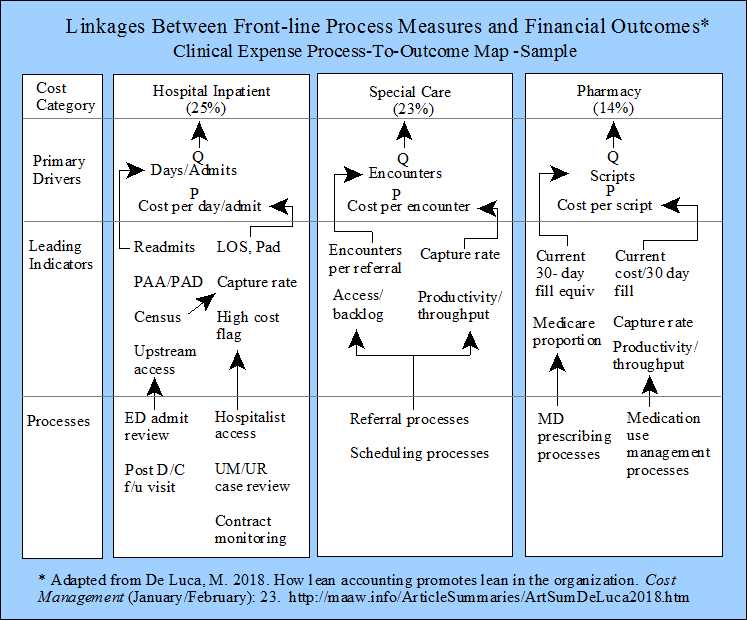
Summary by James R. Martin, Ph.D., CMA
Professor Emeritus, University of South Florida
JIT and Lean Enterprise Main Page | Lean Accounting Main Page
The purpose of this paper is to provide three examples that show how implementing lean concepts in the finance and accounting functions can promote lean in an organization. The examples illustrate how lean accounting and finance make upstream problems visible and provide consultative products and services to help the organization increase customer value.
Example 1: Healthcare Billing
The billing department for a clinical service organization consistently had approximately $8 million in outstanding receivables. The department initiated a problem solving process that involved identifying the root causes, ranking them, and developing countermeasures to address the causes. Their root cause analysis indicated that:
1. the department could not keep up with the volume of billing due to inefficiencies in it's billing processes, and
2. delays in documentation by upstream clinical and business functions that resulted in delays and rework for the billing department.
Developing countermeasures included three process improvement projects:
1. The first project involved developing lean standard work for the billing team, a visual management system, cross-training, work-leveling, and clear standards for when team members should back up other staff.
2. The second project brought clinical and business teams together to find the causes for documentation delays that resulted in delayed billing. This resulted in improved processes that reduced the documentation delays and provided a visual system to monitor the progress improvements.
3. The third project connected the upstream and downstream business functions. This helped the teams see how their processes were interrelated and helped them develop key process improvements.
The improvements resulting from these projects involved a significant reduction in outstanding receivables for the billing department, and many benefits gained by upstream functions that designed and implemented their own improvement systems.
Example 2: Payroll and Human Resources
To reduce waste and rework (e.g., error checking, correcting time cards) the payroll department worked with HR to find root causes and potential improvements. Results included implementing fail safe systems, simplifying handoffs, and eliminating manual duplicative entry of data. In addition, cross-functional standard work processes were developed for a new HR and payroll system.
Example 3: Finance Analysts
To address a lack of capacity the finance analysts department used a four-step process:
1. Assessment of all current work. An assessment tool was developed to evaluate the 400 reports analysts created each month.
2. Elimination of non-value added work. Using the assessment process allowed the department to eliminate two thirds of the reports, freeing up capacity for more beneficial work.
3. Improvement in the efficiency of the remaining work. For example, a single source code was developed to avoid having analysts use seven different queries or code to acquire the necessary data, and to provide more consistent data for all reports.
4. Visual management was implemented for recurring work. A visual system was developed to track all reports including the resource spending required, and the impact on customer value.
The assessment helped identify gaps in reporting, and freed up department capacity to fill the gaps. For example, the department needed to move away from traditional budget-variance reporting, and instead show the linkages between front-line process improvements and financial outcomes. The illustration below shows some of the linages used to develop more comprehensive analysis and reporting.
Linkages between front-line measures and financial outcomes

In addition to the changes described above, the finance analysts shifted their emphasis to a root-cause analysis approach from the previous emphasis on budget variance analysis. They also initiated production and consulting processes, standard work for each phase of the process, cross training, leveling their work, a team orientation, visual management, more dialogue with end users, and continuous improvement all around.
Conclusion
All of the improvements discussed in this paper show how lean accounting and finance promotes lean in the organization and why accountants must become part of the team-based improvement efforts in an organization.
__________________________________________
Related summaries:
Baggaley, B. and B. Maskell. 2003. Value stream management for lean companies, Part I. Journal of Cost Management (March/April): 23-27. (Summary).
Baggaley, B. and B. Maskell. 2003. Value stream management for lean companies, Part II. Journal of Cost Management (May/June): 24-30. (Summary).
Brosnahan, J. P. 2008. Unleash the power of lean accounting. Journal of Accountancy (July): 60-66. (Summary).
Fullerton, R. R. 2003. Performance measurement and reward systems in JIT and non-JIT firms. Cost Management (November/December): 40-47. (Summary).
Fullerton, R. R. and C. S. McWatters. 2002. The role of performance measures and incentive systems in relation to the degree of JIT implementation. Accounting, Organizations and Society 27(8): 711-735. (Summary).
Kapanowski, G. 2016. Lean fundamentals for accountants. Cost Management (January/February): 5-14. (Summary).
Kapanowski, G. 2017. Lean accounting. Cost Management (January/February): 37-41. (Summary).
Kristensen, T. B. and P. Israelsen 2012. Management accounting system problems in context of lean: Development of a proposed solution. In Mitchell, F., H. Norrreklit and M. Jakobsen, eds. 2012. The Routledge Companion to Cost Management. Routledge Companions in Business. (Summary).
Maginnis, M. A. and G. Uminger. 2018. Management accounting in a true lean (TPS) environment. Cost Management (January/February): 27-35. (Summary).
Martin, J. R. Not dated. What is lean accounting? Management And Accounting Web. LeanAccounting.htm
Maskell, B. H. and B. L. Baggaley. 2006. Lean accounting: What's it all about? Target Magazine 22(1): 35-43. (Note).
Patell, J. M. 1987. Adapting a Cost accounting system to just-in-time manufacturing: The Hewlett-Packard Personal Office Computer Division. Accounting & Management Field Study Perspectives, edited by William J. Bruns, Jr. and R. S. Kaplan. Harvard Business School Press: 229-267. (Summary).
Pickering, M. 2017. Implementing lean management reporting in lean enterprises. Cost Management (January/February): 28-36. (Summary).
Toyota Public Affairs Division and Operations Management Consulting Division. 1998. The Toyota Production System: Leaner Manufacturing for a Greener Planet. The Toyota Motor Corporation. (Summary).